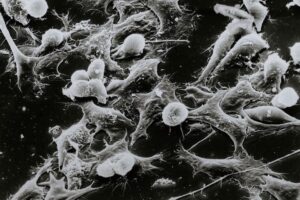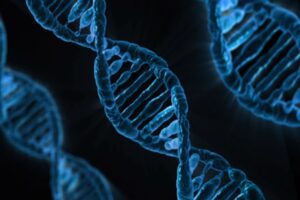
Figure 1: Two of the four Caulobacter crescentus cells are motile with visible flagella, and the other two are sessile with stalks in contact with each other. C. crescentus was the model organism in Mathis and Ackermann’s experiment
Source: Wikimedia Commons
Bacteria often live in environments with changing resource availability, competition, and stressors. There are many ways that bacteria can deal with stress, such as dispersal under oxidative stress, so cell memory can play a key role as well (Stacy et al., 2014; Mathis and Ackermann, 2016). Bacterial cell memory is the phenomenon where the cell reacts to current stressors based on prior experiences; however, there is debate over whether bacteria have “true memories,” due to the fleeting nature of these memories (Andersson, 2016).
Mathis and Ackermann studied the cellular response to saline stress, hypothesizing that stress response would be history-dependent, indicating a form of memory. Caulobacter crescentus was chosen as the model organism because of its abundance in aquatic ecosystems and its asymmetrical division, where one sessile and one motile daughter cell are produced. The bacteria were cultured in microfluidic devices, so the motile cells could be washed away while the sessile cells remained (Mathis and Ackermann, 2016).
The bacterial cells were exposed to saline solutions twice: firstly with an initial warning and secondly with a 100 mM stress. Mathis and Ackermann found that survival was dependent on the timing of the stress event. When the 100 mM saline solution was introduced at intervals of 45 and 120 minutes after the warning, a higher fraction of the bacteria survived compared to other intervals (Mathis and Ackermann, 2016). These rates of increased survival fluctuated in a cyclical pattern. This pattern was caused by the synchronization of C. crescentus’ cell cycle as all cells halted division and most underwent cellular division after 60 minutes, irrespective of their current position in the cell cycle (Mathis and Ackermann, 2016). Since its cell cycle is 60 minutes long, this delay synchronized the population’s life cycle and persisted for up to 16 hours. Additionally, the timing of the stress event in the cell cycle of C. crescentus played a large role in whether the cell would survive or not. If the stress event occurred in the middle of the cell cycle, only roughly 20% of the cell fraction of C. crescentus cells survived. If the stress event occurred near the beginning or end of the cell cycle, roughly 7-% of the C. crescentus cells survived (Mathis and Ackermann, 2016).
Ultimately, on the individual level, C. crescentus showed no long-term memories of saline stress. Bacteria that were exposed to the 100 mM stressor directly after the 80 mM warning did appear to have some cellular memory, with increased levels of the stress response protein, sigma T (σT), but only for a short duration (Mathis and Ackermann 2016). Although these two researchers were unable to show true bacterial memory, Mathis and Ackermann’s experiment showed the intertwined nature of C. crescentus’ stress response and its cell cycle.
References
Andersson, S. G. (2016). Stress management strategies in single bacterial cells. Proceedings of the National Academy of Sciences, 113(15), 3921-3923. https://www.pnas.org/content/113/15/3921.
Mathis, R., & Ackermann, M. (2016). Response of single bacterial cells to stress gives rise to complex history dependence at the population level. Proceedings of the National Academy of Sciences, 113(15), 4224-4229. https://www.pnas.org/content/113/15/4224.
Stacy, A., Everett, J., Jorth, P., Trivedi, U., Rumbaugh, K. P., & Whiteley, M. (2014). Bacterial fight-and-flight responses enhance virulence in a polymicrobial infection. Proceedings of the National Academy of Sciences, 111(21), 7819-7824. https://www.pnas.org/content/111/21/7819.
Related Posts
Antibody-Dependent Cellular Cytotoxicity (ADCC): An Immune Arsenal Against Disease
Figure 1: White Blood cells fighting tumor cells. (Source: National...
Read MoreHuman Endogenous Retroviruses Might Unlock a New Field of Neurodegenerative Disease Research
Figure 1: Researchers have found viral genetic materials within the...
Read MoreBispecific Antibody Recruits Vγ9+ γδ T cells for Leukemia Treatment
Figure 1: The image is taken from an elderly woman...
Read MoreRori Stuart



